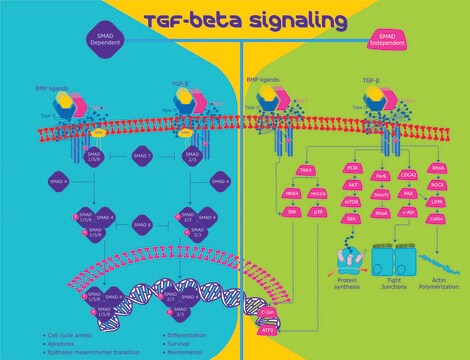B1814
BMP2, human
Carrier Free, ≥98% (SDS-PAGE), recombinant, expressed in E. coli, lyophilized powder, suitable for cell culture
Synonim(y):
BMP-2
About This Item
Polecane produkty
product name
Bone Morphogenetic Protein 2 human, Carrier Free, ≥98% (SDS-PAGE), recombinant, expressed in E. coli, lyophilized powder, suitable for cell culture
pochodzenie biologiczne
human
Poziom jakości
rekombinowane
expressed in E. coli
Próba
≥98% (SDS-PAGE)
Postać
lyophilized powder
masa cząsteczkowa
26 kDa
opakowanie
pkg of 10 μg
warunki przechowywania
avoid repeated freeze/thaw cycles (Do not store in a frost-free freezer.)
metody
cell culture | mammalian: suitable
zanieczyszczenia
Endotoxin, tested
kolor
white
rozpuszczalność
water: soluble 0.100 mL, clear, colorless
numer dostępu UniProt
temp. przechowywania
−20°C
informacje o genach
human ... BMP2(650)
Szukasz podobnych produktów? Odwiedź Przewodnik dotyczący porównywania produktów
Działania biochem./fizjol.
Postać fizyczna
Komentarz do analizy
Kod klasy składowania
11 - Combustible Solids
Klasa zagrożenia wodnego (WGK)
WGK 3
Temperatura zapłonu (°F)
104.0 °F - closed cup
Temperatura zapłonu (°C)
40.0 °C - closed cup
Certyfikaty analizy (CoA)
Poszukaj Certyfikaty analizy (CoA), wpisując numer partii/serii produktów. Numery serii i partii można znaleźć na etykiecie produktu po słowach „seria” lub „partia”.
Masz już ten produkt?
Dokumenty związane z niedawno zakupionymi produktami zostały zamieszczone w Bibliotece dokumentów.
Nasz zespół naukowców ma doświadczenie we wszystkich obszarach badań, w tym w naukach przyrodniczych, materiałoznawstwie, syntezie chemicznej, chromatografii, analityce i wielu innych dziedzinach.
Skontaktuj się z zespołem ds. pomocy technicznej



